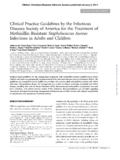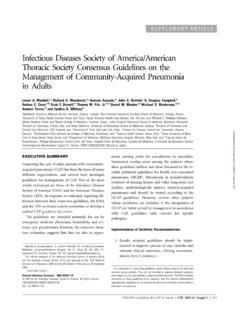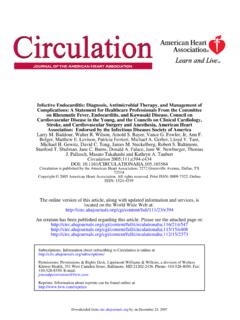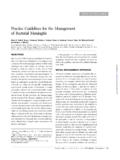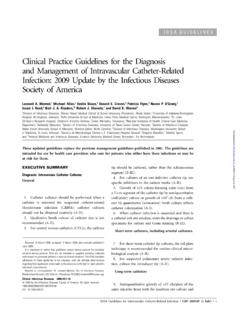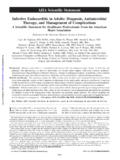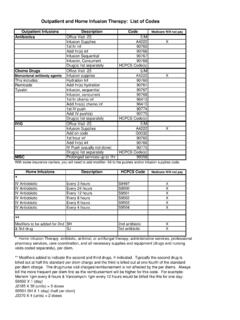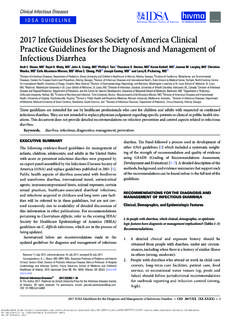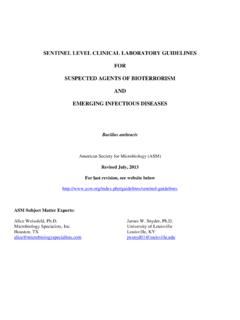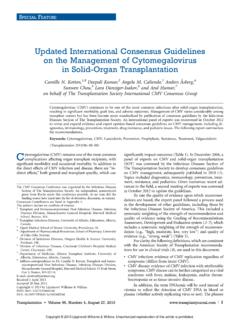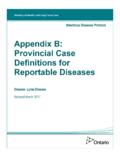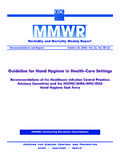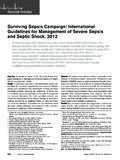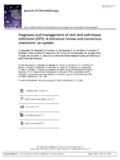Transcription of The Clinical Assessment, Treatment, and Prevention …
1 IDSA guidelines CID 2006:43 (1 November) 1089 IDSA GUIDELINESThe Clinical Assessment, Treatment, and Preventionof Lyme disease , Human Granulocytic Anaplasmosis,and Babesiosis: Clinical Practice guidelines by theInfectious Diseases society of AmericaGary P. Wormser,1 Raymond J. Dattwyler,2 Eugene D. Shapiro,5,6 John J. Halperin,3,4 Allen C. Steere,9 Mark S. Klempner,10 Peter J. Krause,8 Johan S. Bakken,11 Franc Strle,13 Gerold Stanek,14 Linda Bockenstedt,7 Durland Fish,6J. Stephen Dumler,12and Robert B. Nadelman1 Divisions of1 infectious Diseases and2 Allergy, Immunology, and Rheumatology, Department of Medicine, New York Medical College, Valhalla,and3 New York University School of Medicine, New York, New York;4 Atlantic Neuroscience Institute, Summit, New Jersey.
2 Departments of5 Pediatrics and6 Epidemiology and Public Health and7 Section of Rheumatology, Department of Medicine, Yale University School of Medicine,New Haven, and8 Department of Pediatrics, University of Connecticut School of Medicine and Connecticut Children s Medical Center, Hartford;9 Division of Rheumatology, Allergy, and Immunology, Massachusetts General Hospital, Harvard Medical School, and10 Boston University School ofMedicine and Boston Medical Center, Boston, Massachusetts;11 Section of infectious Diseases, St. Luke s Hospital, Duluth, Minnesota;12 Divisionof Medical Microbiology, Department of Pathology, The Johns Hopkins Medical Institutions, Baltimore, Maryland;13 Department of InfectiousDiseases, University Medical Center, Ljubljana, Slovenia; and14 Medical University of Vienna, Vienna, AustriaEvidence-based guidelines for the management of patients with Lyme disease , human granulocytic anaplasmosis(formerly known as human granulocytic ehrlichiosis), and babesiosis were prepared by an expert panel of theInfectious Diseases society of america .
3 These updated guidelines replace the previous treatment guidelinespublished in 2000 (Clin Infect Dis 2000; 31[Suppl 1]:1 14). The guidelines are intended for use by health careproviders who care for patients who either have these infections or may be at risk for them. For each of theseIxodestickborne infections, information is provided about Prevention , epidemiology, Clinical manifestations,diagnosis, and treatment. Tables list the doses and durations of antimicrobial therapy recommended fortreatment and Prevention of Lyme disease and provide a partial list of therapies to be avoided.
4 A definitionof post Lyme disease syndrome is SUMMARYB ackgroundLyme disease is the most common tickborne infectionin both North america and Europe. In the UnitedReceived 21 August 2006; accepted 21 August 2006; electronically published2 October guidelines were developed and issued on behalf of the InfectiousDiseases society of is important to realize that guidelines cannot always account for individualvariation among patients. They are not intended to supplant physician judgmentwith respect to particular patients or special Clinical situations.
5 The InfectiousDiseases society of america considers adherence to these guidelines to bevoluntary, with the ultimate determination regarding their application to be madeby the physician in the light of each patient s individual or correspondence: Dr. Gary P. Wormser, Rm. 245, Munger Pavilion,New York Medical College, Valhalla, NY 10595 infectious Diseases2006; 43:1089 134 2006 by the infectious Diseases society of america . All rights $ , Lyme disease is caused byBorrelia burgdorferi,which is transmitted by the bite of the tick speciesIxodesscapularisandIxodes manifestationsmost often involve the skin, joints, nervous system, andheart.
6 Extracutaneous manifestations are less com-monly seen than in earlier years. Early cutaneous in-fection withB. burgdorferiis called erythema migrans,which is the most common Clinical manifestation ofLyme scapularismay also be infected withand transmitAnaplasma phagocytophilum(previouslyreferred to asEhrlichia phagocytophila) and/orBabesiamicroti,the primary cause of babesiosis. Thus, a bitefrom anI. scapularistick may lead to the developmentof Lyme disease , human granulocytic anaplasmosis(HGA, formerly known as human granulocytic ehrli-chiosis), or babesiosis as a single infection or, less fre-quently, as a findings are sufficient at IDSA on August 14, from 1090 CID 2006.
7 43 (1 November) Wormser et Diseases society of america US PublicHealth Service Grading System for ranking recommendationsin Clinical , gradeDefinitionStrength of recommendationAStrongly in favorBModerately in favorCOptionalDModerately againstEStrongly againstQuality of evidenceIEvidence from 1 properly ran-domized, controlled trialIIEvidence from 1 well-designedclinical trial, without randomi-zation; from cohort or case-controlled analytic studies(preferably from11 center);from multiple time seriesstudies; or from dramatic re-sults from uncontrolledexperimentsIIIE vidence from opinions of re-spected authorities, based onclinical experience, descriptivestudies, or reports of reflect the strength of each recommendation for oragainst use and the quality of the the diagnosis of erythema migrans, but Clinical findings aloneare not sufficient for diagnosis of extracutaneous manifestationsof Lyme disease or for diagnosis of HGA or performed in laboratories with excellent quality-controlprocedures is required for confirmation of extracutaneous Lymedisease, HGA.
8 And Bites and Prophylaxis of Lyme DiseaseThe best currently available method for preventing infectionwithB. burgdorferiand otherIxodesspecies transmitted path-ogens is to avoid exposure to vector ticks. If exposure pacificusticks is unavoidable, measures rec-ommended to reduce the risk of infection include the use ofboth protective clothing and tick repellents, checking the entirebody for ticks daily, and prompt removal of attached ticksbefore transmission of these microorganisms can occur (B-III)(see table 1 for recommendation categories, which are indicatedin parentheses throughout this text).
9 For Prevention of Lyme disease after a recognized tick bite,routine use of antimicrobial prophylaxis or serologic testing isnot recommended (E-III). A single dose of doxycycline maybe offered to adult patients (200 mg dose) and to children 8years of age (4 mg/kg up to a maximum dose of 200 mg) (B-I) whenallof the following circumstances exist: (a) the attachedtick can be reliably identified as an adult or nymphalI. sca-pularistick that is estimated to have been attached for 36 hon the basis of the degree of engorgement of the tick withblood or of certainty about the time of exposure to the tick;(b) prophylaxis can be started within 72 h of the time that thetick was removed; (c) ecologic information indicates that thelocal rate of infection of these ticks withB.
10 Burgdorferiis 20%;and(d) doxycycline treatment is not contraindicated. The timelimit of 72 h is suggested because of the absence of data onthe efficacy of chemoprophylaxis for tick bites following tickremoval after longer time intervals. Infection of 20% of tickswithB. burgdorferigenerally occurs in parts of New England,in parts of the mid-Atlantic States, and in parts of Minnesotaand Wisconsin, but not in most other locations in the UnitedStates. Whether use of antibiotic prophylaxis after a tick bitewill reduce the incidence of HGA or babesiosis is is relatively contraindicated in pregnant womenand children!
